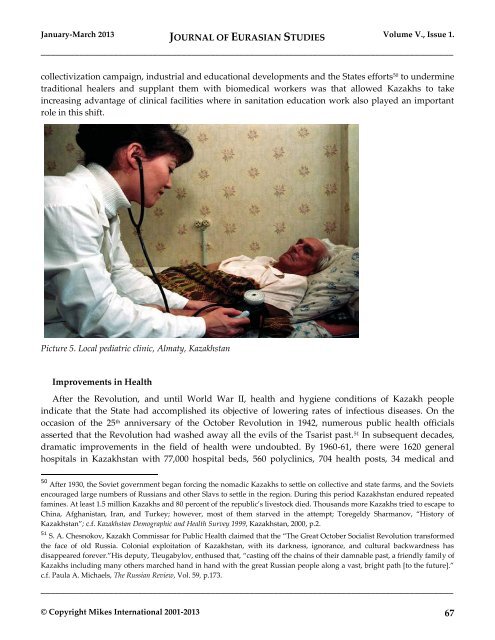JOURNAL OF EURASIAN STUDIES Journal of the Gábor Bálint de ...
JOURNAL OF EURASIAN STUDIES Journal of the Gábor Bálint de ...
JOURNAL OF EURASIAN STUDIES Journal of the Gábor Bálint de ...
Create successful ePaper yourself
Turn your PDF publications into a flip-book with our unique Google optimized e-Paper software.
January-March 2013 <strong>JOURNAL</strong> <strong>OF</strong> <strong>EURASIAN</strong> <strong>STUDIES</strong> Volume V., Issue 1.<br />
_____________________________________________________________________________________<br />
collectivization campaign, industrial and educational <strong>de</strong>velopments and <strong>the</strong> States efforts 50 to un<strong>de</strong>rmine<br />
traditional healers and supplant <strong>the</strong>m with biomedical workers was that allowed Kazakhs to take<br />
increasing advantage <strong>of</strong> clinical facilities where in sanitation education work also played an important<br />
role in this shift.<br />
Picture 5. Local pediatric clinic, Almaty, Kazakhstan<br />
Improvements in Health<br />
After <strong>the</strong> Revolution, and until World War II, health and hygiene conditions <strong>of</strong> Kazakh people<br />
indicate that <strong>the</strong> State had accomplished its objective <strong>of</strong> lowering rates <strong>of</strong> infectious diseases. On <strong>the</strong><br />
occasion <strong>of</strong> <strong>the</strong> 25 th anniversary <strong>of</strong> <strong>the</strong> October Revolution in 1942, numerous public health <strong>of</strong>ficials<br />
asserted that <strong>the</strong> Revolution had washed away all <strong>the</strong> evils <strong>of</strong> <strong>the</strong> Tsarist past. 51 In subsequent <strong>de</strong>ca<strong>de</strong>s,<br />
dramatic improvements in <strong>the</strong> field <strong>of</strong> health were undoubted. By 1960-61, <strong>the</strong>re were 1620 general<br />
hospitals in Kazakhstan with 77,000 hospital beds, 560 polyclinics, 704 health posts, 34 medical and<br />
50 After 1930, <strong>the</strong> Soviet government began forcing <strong>the</strong> nomadic Kazakhs to settle on collective and state farms, and <strong>the</strong> Soviets<br />
encouraged large numbers <strong>of</strong> Russians and o<strong>the</strong>r Slavs to settle in <strong>the</strong> region. During this period Kazakhstan endured repeated<br />
famines. At least 1.5 million Kazakhs and 80 percent <strong>of</strong> <strong>the</strong> republic’s livestock died. Thousands more Kazakhs tried to escape to<br />
China, Afghanistan, Iran, and Turkey; however, most <strong>of</strong> <strong>the</strong>m starved in <strong>the</strong> attempt; Toregeldy Sharmanov, “History <strong>of</strong><br />
Kazakhstan”; c.f. Kazakhstan Demographic and Health Survey 1999, Kazakhstan, 2000, p.2.<br />
51 S. A. Chesnokov, Kazakh Commissar for Public Health claimed that <strong>the</strong> “The Great October Socialist Revolution transformed<br />
<strong>the</strong> face <strong>of</strong> old Russia. Colonial exploitation <strong>of</strong> Kazakhstan, with its darkness, ignorance, and cultural backwardness has<br />
disappeared forever.”His <strong>de</strong>puty, Tleugabylov, enthused that, “casting <strong>of</strong>f <strong>the</strong> chains <strong>of</strong> <strong>the</strong>ir damnable past, a friendly family <strong>of</strong><br />
Kazakhs including many o<strong>the</strong>rs marched hand in hand with <strong>the</strong> great Russian people along a vast, bright path [to <strong>the</strong> future].”<br />
c.f. Paula A. Michaels, The Russian Review, Vol. 59, p.173.<br />
_____________________________________________________________________________________<br />
© Copyright Mikes International 2001-2013 67

















